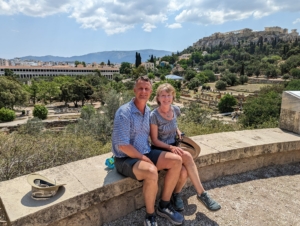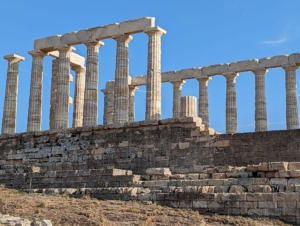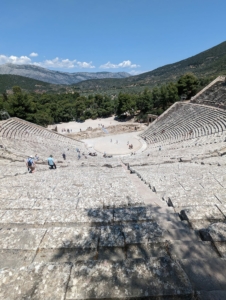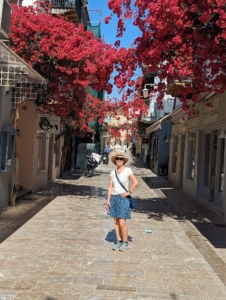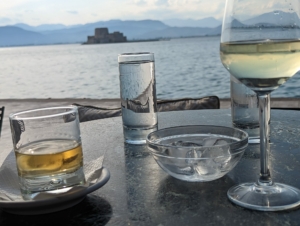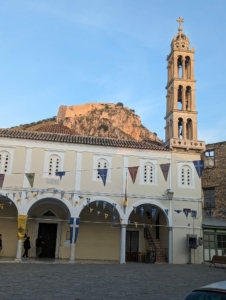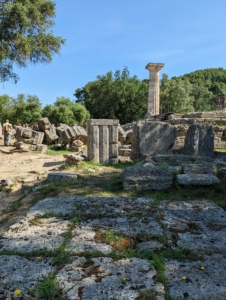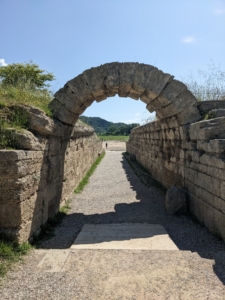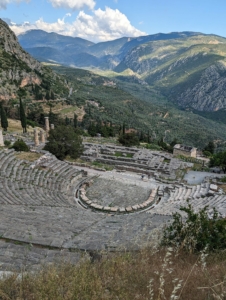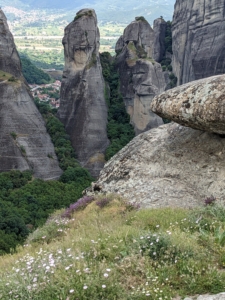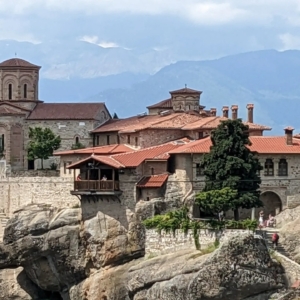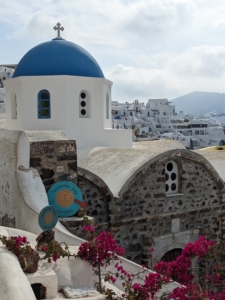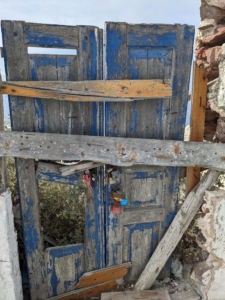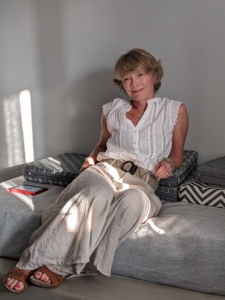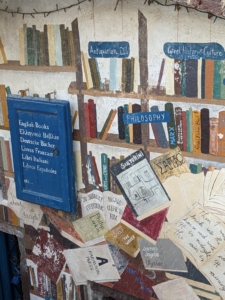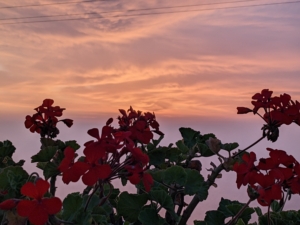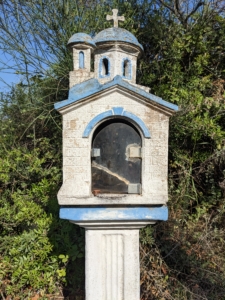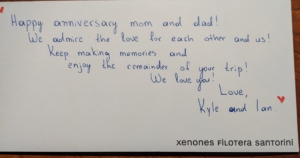It’s no longer all Greek to me
My husband Brad and I each have travel bucket lists. Years ago we wrote out 10 different locations we wanted to visit, without consulting with each other. Amazingly, (or maybe not as we’ve been together for nearly forty years) we both chose some of the same countries.
Greece was one of them.
We checked off this destination in style in honor of our 35th wedding anniversary.
After two weeks of taking in Athens, the Peloponnese, and the island of Santorini, the following quote from Socrates, the Greek philosopher sums up our Grecian experiences.
“True wisdom comes to each of us when we realize how little we understand about life, ourselves, and the world around us.”
We came to understand rather quickly how little we knew about this country. Now that we are back stateside, perhaps this post will help enlighten you all a bit on all we experienced and learned.
(Note I have embedded links for those who wish to learn more.)
The Parthenon is an optical illusion
![]() Brad and I with Acropolis and the Parthenon in the background.
Brad and I with Acropolis and the Parthenon in the background.
It is absolutely mind-boggling to understand that the Parthenon, sitting high on the Acropolis overlooking Athens, has virtually no right angles in this monument dedicated to Athena. The base is domed, not flat. Ictinus and Callicrates, the architects of the structure, along with Phidias, the sculptor, wanted us to believe that in viewing the wonder, we would see something balanced. They built the whole structure so that it is slightly curved in the middle as if rising to the gods. Some suggest that the facade of the Parthenon has the proportions of what is known as the Golden Ratio.
Did I mention the monument is 2500 years old?
I look forward to watching this PBS documentary on the Parthenon to learn more…
Cape Sounion has a storied past
Poseidon’s temple at Cape Sounion
Legend has it that Aegus, the king of Athens, leaped to his death at this strategic point, after thinking his son had died in battle against the Minotaur in Crete. Theseus, the son, was victorious, but he forgot to change the sails on the ship from black (indicating defeat and death) to white victorious flags. Upon seeing the black sails, Aegus gave up hope and dove into the water that is now known as the Aegean Sea.
The temple was built with the intent to appease Poseidon, the god of the seas, in the hopes it would calm his anger, and as a result, the waters around the cape. On the evening we visited, the water was calm. I think Poseidon was pleased.
The Ancient Theater in Epidauras would be an awesome concert site!
You can hear a pin drop from the center of the stage all the way to the top seats of this theater built in the late 4th century BC. The annual Athens Epidaurus Festival still stages events at the 15,000-seat amphitheater annually.
I was checking out real estate in Nafplion.
Oh my goodness. I loved this little town on the Gulf of Argolis. The streets are quintessential European, with cobbled stones and bougainvillea creating a fragrant canopy. We enjoyed a cocktail looking out to Bourtzi Island, with the Venetian fortress rising from the water. The next morning we hiked the 999 steps up to the fortress in Palamidi overlooking the city. Note how it towers over the square in the picture.
The view from the top was incredible.
![]() Thank goodness women are now allowed at the site of the original Olympics!
Thank goodness women are now allowed at the site of the original Olympics!
The archeological site of Olympia, where the original Olympic Games were held, is open to all. Not the case back in the day, when women were not allowed, according to our guide. But, I have since come to understand that there was a separate festival to honor Hera, the wife of Zeus. Unmarried girls ran foot races! Imagine…the women’s marathon didn’t debut at the Olympics until 1984. That’s A.D.
Ruins in Olympia. The Krypte, the entrance to the Olympic stadium
The center of the world in ancient Greece…Delphi
View over the Theater and Stadium, where the Pythian Games were held every four years.
Legend has it that two giant eagles were released by Zeus one to the East, and one to the West. They met in Delphi, thus determining that this was the center point of the world. Delphi is the sanctuary of Apollo, the god of light, knowledge, and harmony. The ruins still reflect the gifts that were brought to the site in the hopes to win favor with Apollo. Think bribery in ancient Greek times.
Pythia, the oracle of Delphi, was quite an attraction at the time. People traveled from all over to get questions answered by this high priestess of Apollo. Whether you were a farmer wishing to know when to plant seeds, or when a child might come to a woman, the oracle provided answers. If it wasn’t the truth you were seeking, with a donation of a little more gold, you might receive the message you were hoping for. Images of the Wizard of Oz came to mind as our guide pointed out the openings where smoke would erupt from, surrounding the oracle in a cloak of mystery.
How do you say Meteora? How do you describe the indescribable?
So…these are the huge sandstone rock pillars that rose out of a valley about 60 million years ago. Hermit monks came here in the 9th and 10th centuries for isolation and to seek spiritual sanctuary.
Eventually, 24 monasteries were built on these rock formations. Only six remain today. We visited two of them. The Monastery of Saint Barbara (my patron saint from confirmation) and the Monastery of Agios Stephanos
To answer the question I posed, Meteora is pronounced Mee-Tee-Ah-Ruh.
I’m still trying to find the words to describe the indescribable.
Santorini has got a vibe.
We flew from Athens to Santorini for the last four nights of our trip. We hiked along the caldera from Oia to Fira. We enjoyed gyros and white Santorini wine. We visited the excavation site at Akitori. We hung out with 30-somethings on a sunset cruise who proclaimed we were “adorable” (isn’t that how one refers to old people?) and that we repped “couple’s goals.” We caught a sunrise and sun rays. We rehashed our journey…all 35-plus years of love, adventures, joys, sorrows, and everything in between.
Remembrances
This is one of thousands of roadside remembrances that dot the landscape in Greece. Tributes to those who died on the roadways of the country, it was a stark reminder of how fleeting this life can be. Our guide was kind to stop and explain the rituals involved in visiting one of the sites. Often there is a small oil-based lamp and a lighter contained within, along with loving notes and memories offered to the loved one who died there. We stopped at this shrine, lit the candle, and offered thoughts and prayers to the family of the deceased. As we walked away, I noticed a stray little purple wildflower at the base.
A final, lasting memory
Our kids both asked us when we returned what our favorite highlight was. It was this…a surprise note, accompanied by a nice bottle of Santorini white wine upon arrival at our hotel.
Yamas, my followers. To love. To your health. To our memories of a country we will always hold dear in our hearts.
To gaining wisdom through an understanding of this amazing world.

